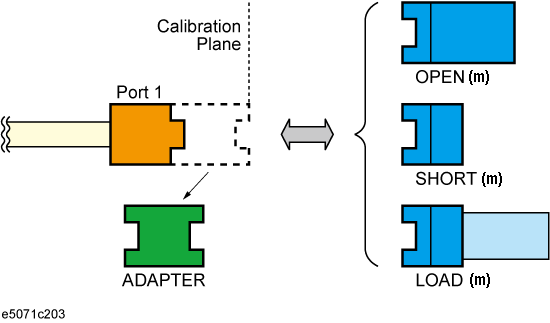
Other topics about Advanced Calibration
Adapter Removal is a technique used to remove any adapter characteristics from the calibration plane. The E5072A uses the following adapter removal process to remove adapter characteristics:
Perform calibration with the adapter in use.
Remove the adapter from the port and measure Open, Short, and Load values to determine the adapter's characteristics.
Remove the obtained adapter characteristics from the error coefficients in a de-embedding fashion.
Open, Short, and Load values measured with the adapter removed

The adapter removal and partial overwrite function is only available when the calibration status is [Corr] and not for [C?] or [C!].
This above described method also makes it possible to add adapter characteristics to a port with n-port full calibration. This allows you to make a measurement with the adapter. E5072A uses the following adapter insertion process to insert adapter characteristics:
Perform calibration without adapter in use.
Insert the adapter to the port and measure Open, Short, and Load values to determine the adapter's characteristics.
Insert the obtained adapter characteristics to the error coefficients in an embedding fashion.
Open, Short, and Load values measured with adapter attached
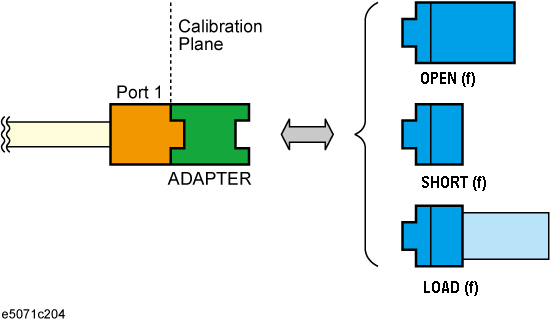
In order to determine the adapter characteristics (with four unknown parameters) by making three measurements (Open, Short, and Load), the adapter must satisfy the following requirements:
Adapter must be Reciprocal (with S21 and S12 equal) in nature. It should have a consistent behavior, independent of the direction from which it is used.
The electrical length of Adapter should be known at an accuracy of ±1 /4 of wavelength.
E5072A also allows adapter waveguide length and cut off frequency to be set using the following commands:
SCPI.SENSe(Ch).CORRection.COLLect.ADAPter(Pt).WAVeguide.LENGth
SCPI.SENSe(Ch).CORRection.COLLect.ADAPter(Pt).WAVeguide.CUToff
Coaxial length can be set using Cal > Calibrate > Adapter Removal > Coaxial Length
Rotate command executes Adapter Removal/Insertion along with moving the phase of adapter (which is removed or inserted) to 180 degrees. This command is useful in cases where auto judgement of phase fails. This command can be executed several times while the calibration remains valid.
SCPI.SENSe(Ch).CORRection.COLLect.ADAPter(Pt).ROTate
System Z0 should be changed to 1 Ω before calibration when using waveguide calibration kit and measuring waveguide devices.
Some calibration kits such as the waveguide calibration kit have operational frequency range defined by Minimum and Maximum frequency. When the E5072A stimulus setting is out of the operational frequency range, you cannot click Done or finish the calibration by remote control. In this case, use a calibration kit that has proper frequency range, or change the E5072A stimulus setting to proper range that the calibration kit can cover. Refer to the calibration kit manual or definition in the E5072A with Cal > Modify Cal Kit > Define STDs for the Maximum & Minimum frequency of the calibration kit.
This section provides an example of performing adapter waveguide calibration to perform a full 2-port calibration plane between Port 1 (3.5mm) & Port 2 (P-band wave guide).
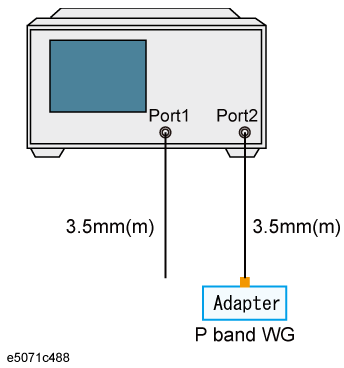
Using Adapter Insertion:
Perform a SOLT F2P Calibration at Port 1 (3.5mm) using Z0=50 Ω
Perform Adapter insertion at Port 2 (Z0=1) using P11644A
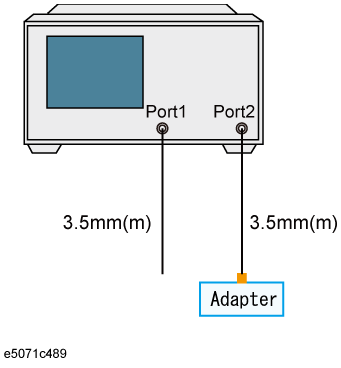
Using Adaptor Removal:
Perform a SOLT/TRL F2P Calibration at P band WG (Z0 = 1)
Perform Adapter removal at port 1 (Z0=50) using 85052D
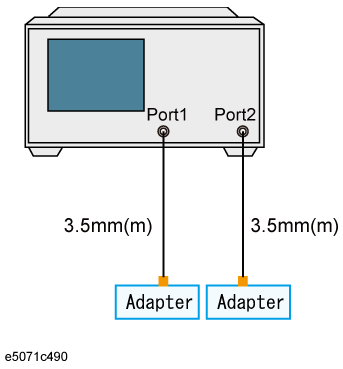
Using Port Extension:
Perform a SOLT F2P calibration at Port 1 (3.5mm) with Z0 = 50
Perform Port extension calibration at Port 2 (manual with Coax length, WG length, Cut off). System Z0 can be either 1 oh or 50 Ω ; both are fine to use.
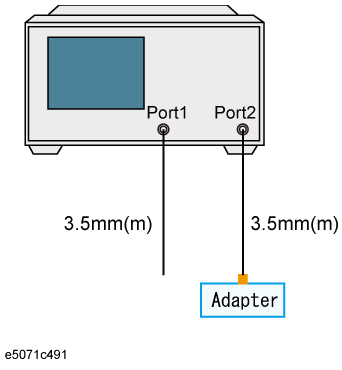
The -Parameter of a reciprocal adapter can be determined when the following data is available:
Open, Short, and Load measurements.
Actual values derived from the CalKit definitions.
An approximate length of the adapter.
Nature of the intended operation: removal or insertion.
If the frequency setting is not Zero Span, an approximate length of the adapter should be provided otherwise an error might be generated in the measurement.
For Adapter Removal, the adapter length is (+) Positive. For Adapter Insertion, the Adapter length is (-) Negative.
To change gender of the calibration kit, refer to Defining Calibration Kit Gender.
To use Adapter Removal/Insertion, follow the given procedure:
Perform a full n-port calibration using your calibration kit so that the port used to conduct adapter insertion/removal is calibrated.
When you need to remove an adapter from the calibration plane (adapter removal) to connect your DUT, perform the calibration with an adapter so that you can make a calibration with your calibration kit. When you need to add an adapter into the calibration plane (adapter insertion) to connect your DUT, perform the calibration without an adapter.
Open the Adapter Removal menu:
Cal > Calibrate > Adapter Removal
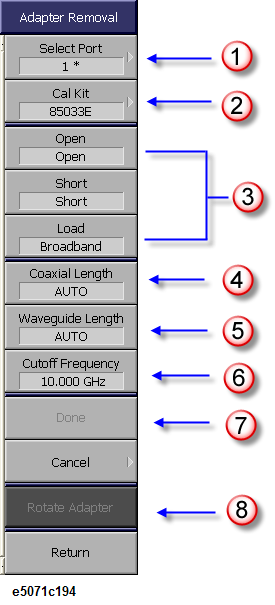
Select the Port in/from which you want to insert/remove Adapter characteristics from Select Port (e.g. 1) (1 in the above figure). A * sign appears in front of the port is a valid port to conduct adapter removal/insertion as the full n-port calibration has been performed on the port.
Select the proper standard Calkit you need to use from CalKit (e.g. 85033E) (2 in the above figure) to characterize the adapter. The calibration kit is used at the plane from which adapter is removed (adapter removal), or the plane in which adapter is inserted (adapter insertion).
If you are using a Coaxial adapter, select the Coaxial Length as Auto for Automatic Insertion/Add, or if you want to input a manual Coaxial Length, type a Coaxial length with Negative or Positive sign (4 in the above figure). For Adapter Removal, the Coaxial length is (+) Positive and for Adapter Insertion, the Coaxial length is (-) Negative.
If you are using a Waveguide or a mixed adapter, select the Cutoff Frequency of the waveguide you want to enter (6 in the above figure). The Cutoff Frequency is defined by the waveguide calibration kit in use.
Without entering the value of Cutoff Frequency, the Waveguide Length cannot be entered.
If you are using a Waveguide or a mixed adapter, select the Waveguide Length as Auto for Automatic Insertion/Add, or if you want to input a manual Waveguide Length, type a value for Waveguide length with Negative or Positive sign (5 in the above figure). For Adapter Removal, the Waveguide length is (+) Positive and for Adapter Insertion, the Waveguide length is (-) Negative.
Change the system Z0 to 1 ohm before calibration when using waveguide calibration kit and measuring waveguide devices.
Connect Open, Short, and Load of the selected Calkit (e.g. 85033E)with the selected port respectively and click/press Open, Short, and Load respectively. ENA measures the cal kit standard, calculates the adapter characteristics, and then conducts adapter removal/insertion.
A checkmark ![]() appears in (Open, Short, and Load) menu after each type of calibration is done, respectively.
appears in (Open, Short, and Load) menu after each type of calibration is done, respectively.
Click Done to complete the process (7 in the above figure).
Some calibration kits such as the waveguide calibration kit have operational frequency range defined by Minimum and Maximum frequency. When the E5072A stimulus setting is out of the operational frequency range, you cannot click Done or finish the calibration by remote control. In this case, use a calibration kit that has proper frequency range, or change the E5072A stimulus setting to proper range that the calibration kit can cover. Refer to the calibration kit manual or definition in the E5072A with Cal > Modify Cal Kit > Define STDs for the Maximum & Minimum frequency of the calibration kit.
In cases where auto judgement of phase fails, select Rotate Adapter to move the phase of adapter (which is removed or inserted) to 180 degrees.
Usually, two-port network analyzers removes adapter characteristics by performing two sets of full 2-port calibration as shown below:
Calibration performed with the adapter connected to Port2
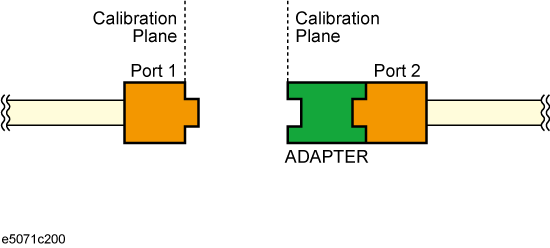
Calibration performed with the adapter connected to Port1
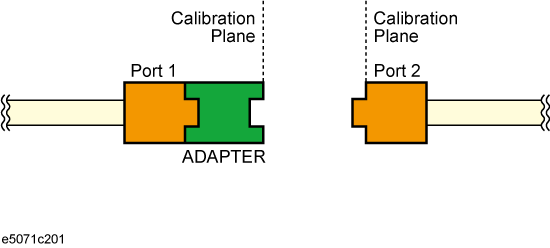
Removing adapter characteristics using two (above) sets of calibration
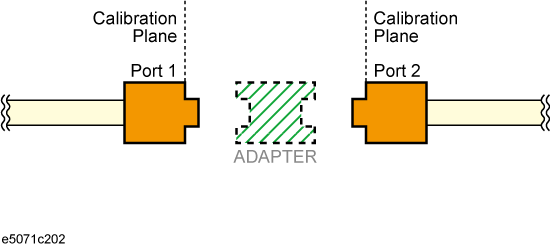
However, this method is not suitable for a multi-port network analyzer because it will require as many sets of full 2-port calibration as twice the number of port combinations. Therefore, the E5072A uses an advanced method to remove Adapter characteristics described in About Adapter Insertion.